Birds and Ninjas - a Brand New Horizon for Chess!
In 1400 AD, the Queen sparked the modern revolution of chess. Now in the new millennium, the Bird with its dual capture mode is poised to make a similar impact.Birds and Ninjas is a game that breaks new boundaries. With its larger board space and diverse multifaceted pieces, this chess variant's new strategy and tactics stimulate the mind differently from its glorious predecessor.
The game is similar to orthodox chess except for the following major differences:
- A larger 10x10 board increases the distance between the two armies, allowing each side to develop their pieces effectively for a more prolonged attack. This configuration forces the players to create more complex plans rather than rely on premature tactical attacks.
White's opening advantage is nullified, and the variety of new undiscovered openings ensure that neither side resorts to cheap tactical tricks using a memorized set of opening moves. - The two additional squares in the center of each side constitute the rear of the "palace". It makes a great hideout for the king, provides an alternative to castling, and can kindle a variety of interesting battle plans as well as new defensive options.
- Flexible castling enables the player to decide whether centralization of rook or king safety is more important.
- The new pieces - the Birds (Flying Bombers), introduce an entirely new type of capturing mechanism into the game. They capture by flying over their victims (see moves).
The Bird also exhibits excellent defensive powers and undertakes fierce attacks utilizing its dual capture mode. Its short-range jumping ability together with its long-range prowess make the Bird a very formidable weapon. - The Ninja Guards (see ninja guards move-set) add the finishing touch to this exquisite game.
The ninja guard, despite its fierce short-range and double capture capabilities controls only 8 squares making it the perfect complementary piece to the knight.
- New Update 4/22/22! The ultimate chess system has been improved to just use Fast Ninja Pawns - no Pawns!
- The optional Ninja Pawn drop rule allows up to 5 special pawns to enter the game via the drop zone (the 2nd rank squares) and optionally pushed forward to the center resulting in more dynamic pawn play.
- The three-step initial pawn move speeds up the game and the en-passant rules are logically extended (if regular pawns are used only- ninja pawns do not use en-passant rules).
Board Setup
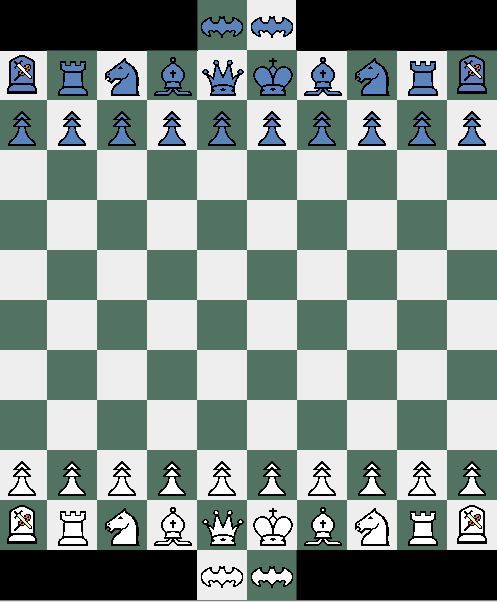 |
Birds and Ninjas main Start position
Coordinates for white. (black mirrors white) Flying bombers on e0, f0 Ninja Guards on a1, j1 Rooks on b1,i1 knights on c1,h1 bishops on d1, g1 queen on e1 king on f1 Ninja Pawns can be dropped to a1-j1 The original/alternative positions can also be tried. |
The harmonizing effect
Orthodox chess has one pair of jumping pieces(the knights), two pairs of sliding pieces (the rooks and bishops) plus one very powerful sliding piece: the queen.
In Birds and Ninjas, the sliding pieces are harmonized with two pairs of leaping pieces (the ninja guards and knights), and a pair of dual jumper/slide pieces: the flying bombers.
The flying bomber, however, adds a distinctive flavor to the game: it flies over the enemy to capture!
In the strictest sense, it is not a slider, but a short-range jumper and a long-range flier.
The Ninja Guard compliments the Knight in very much the way the Bishop does in the 8x8 chess board.
Why wait? Dig right in, discover more and play the game!
The Bird’s (Flying Bomber’s) Moves
*The flying bomber's shape resembles a bat, hence the iconographic symbols used. However, the flying bomber is also referred to as the "Bird" - a common nickname given to fighter planes. The choice of name is left to the player.
The flying bomber's odd combination of long-range and short-range moves makes it a deadly weapon against an unsuspecting opponent.
Standard Move:- The flying bomber eliminates an enemy piece by flying over it, and landing on THE empty square immediately after it on the same orthogonal line. It cannot fly over or capture a second piece or land on any square beyond the first empty square.
- The flying bomber can fly along any amount of empty squares (1-9) orthogonally, but not over any friendly pieces. This is identical to the movement of a rook.
Special Move: the Helicopter Landing
This is a special maneuver that enables the bird to fly over the adjacent square, (jumping over, if occupied by friendly piece or eliminating if occupied by enemy piece) and land like a helicopter on a square exactly 2 squares away, capturing if possible on this square. It can capture two pieces in this manner.Essentially, it combines its standard move with that of a two space orthogonal jumper.
This peculiar short-range prowess in more detail:
- The Flying Bomber can fly over one friendly piece adjacent to it (left, right, up or down) and land on an empty square immediately after it. When it flies over an adjacent friendly piece, its range is limited to two squares.
- If an enemy piece is exactly 2 squares away orthogonally and no other piece is in-between, then the flying bomber can capture the usual way by flying over it and landing on the empty square after it. It can also capture by landing on the same square as the enemy.
- If two enemy pieces lie on the same line, the first one adjacent to the flying bomber, and the next two squares away, then it can eliminate both pieces by landing on the square of the second enemy piece. (see diagram 1) It cannot fly over the second enemy piece.
- Similarly, if there was a friendly piece in immediate vicinity of the flying bomber, and an enemy piece right after it, then the bird can fly over the friendly piece and destroy the piece right after by landing on the same square. Here too it cannot fly over beyond the enemy piece as it cannot fly over two pieces.
- The Flying Bomber needs at least one square to fly over for a bombing. e.g. it can destroy any enemy piece in its vicinity (1 square to left, right, up or down) by flying over it and landing on the empty square after it, but if a friendly piece occupies a square immediately after the enemy piece, no capture can be made. (see diag 2)
- It must capture the enemy piece it jumps over. (capturing is not optional).
It is easier to remember the flying bomber moves as a combination of the standard move with the move of the Dabbabah - a leaping move two squares in any orthogonal direction.
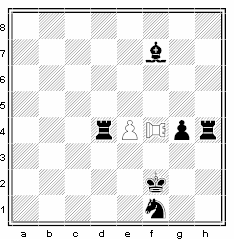 diag 1 (sideways rook rep. flying bomber) |
Diag. 1: The flying bomber on f4 is posing multiple threats to black's pieces.
It is threatening to destroy the black bishop on f7 by moving f4-f8. Using its special 2 square helicopter capability, it is threatening the black rook on d4 by moving f4-d4 (flying over its own piece and bombing/landing on d4). It cannot land on any squares beyond d4. This same short-range prowess gives it the ability to threaten f4-h4, flying over and bombing pawn on g4 and landing/bombing rook on h4. Note that the bomber cannot move to g4 by capturing the pawn, it must eliminate both the pawn and the rook. If there was no rook on h4 then the bomber can just capture the pawn by moving f4-h4. Note that the bird IS giving check to the king because it is exactly 2 squares away, and the bird can land on f2. However the bird is not threatening the knight on f1 since it is more than 2 squares away and there is no empty square beyond it. If the king moves, the knight will not be under attack either. |
 diag 2 (sideways rook rep. flying bomber) |
Diag 2: Here the Flying Bomber is hampered by Black’s Pieces.
It is not checking the king at d7 because there is no empty square behind it (and it is not exactly 2 squares away from it). The rook on d8 is pinned, because moving it would enable the king to be captured. However, the king can simply move away and the rook on d8 is not threatened because there is no empty square beyond it. The rook on e4 is adjacent to the flying bomber and threatening it. But the Flying Bomber cannot do anything because the white pawn occupies f4 and the bomber needs an empty square after its target. If f4 was an empty square, the bomber could capture the rook, and if there was another enemy piece on f4 instead of the white pawn, then the bomber could have captured both pieces. The Flying Bomber does attack the pawn on d2. It can fly d4-d1 OR move d4-d2 to eliminate the pawn. Because it is 2 squares away, the bomber can land on the same square as its target. |
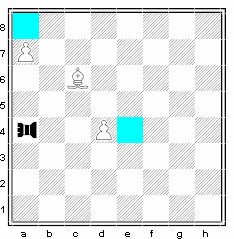 diag 3 (sideways rook rep. flying bomber) |
Diag 3:
Here the black Flying Bomber is threatening white’s pawns at d4 and a7.
However, the white bishop is defending both pawns (colored squares). To make matters worse the bishop is also attacking the bird! |
The Ninja Guard’s Moves
The Ninja Guard is a color bound piece that can move one or two steps diagonally. It can leap over a diagonally adjacent friendly piece to land exactly 2 squares away (a two-space diagonal leap). It can capture on any square it lands, and additionally it can can capture an enemy piece that is diagonally adjacent by jumping over it. It can capture two pieces (the first immediately adjacent to it, and the next right after) in its path on a diagonal by jumping over the first one and capturing the second piece on the square it lands.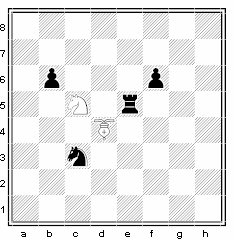 |
The Ninja Guard on d4 can capture all the pieces in the diagram.
It can capture the pawn on b6 by jumping over the knight at c5. It can capture the knight on c3 by moving to c3 or by jumping over the knight and landing on b2. It can capture the rook on e5 by moving to e5 or it can capture both the rook and the pawn by jumping over to f6. |
For simplicity, the above diagrams showed a standard 8x8 chessboard, and not the actual 10X10 board space used by Birds and Ninjas.
The Ninja Pawn

 The ninja pawn possesses slightly different modes of movement and capture depending on which half of the board it is on.
The ninja pawn possesses slightly different modes of movement and capture depending on which half of the board it is on.
Movement:
The ninja pawn can always move 1 square up or 1 square sideways to an empty square regardless of where it is situated on the board.
From the middle exactly, (rank 5 for white, rank 6 for black), the ninja pawn can move only 1 square forward, but thereafter as soon as it enters enemy territory (the upper half of the board: White rank 6-10, and for black rank 5 - 1), the pawn can go forward either 1 OR 2 empty spaces
Capture:
Like the standard pawn it can capture one square diagonally up, regardless of which half of the board it is on.
When the ninja pawn is on the top half of board (White rank 6 +, Black rank 5-) , it can also capture one square horizontally.
There is no en passant. It cannot capture another pawn or ninja pawn en passant nor can any other pawn capture it this way.
Promotion: The ninja pawn promotes on the last row (rank 10 for white, rank 1 for black), to any piece. Promotion to a piece is mandatory so it would cease to be a pawn in the last row.
Dropping:
The ninja pawn is not present at the start at the game and is dropped by the player into the drop zone, which are the 2nd row squares (row 9 for black, 2 for white). For example, the drop zone for white is a2-j2 and for black a9-j9.
The square must be vacant to drop the pawn. You can drop a pawn to check or to checkmate the opposing king
A maximum of 5 ninja pawns (1 per turn) can be dropped by each side during a game.
After dropping a pawn, the player can optionally move the ninja pawn forward 1 or multiple squares towards the center on the same move.
A capture or a side move is not permitted during the drop, so the player can just drop a pawn, or drop a pawn and move it 1-3 vacant squares towards the center.
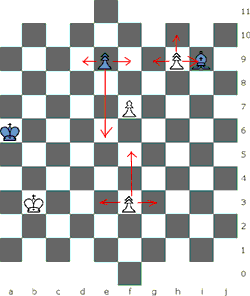 |
In diagram, the black ninja pawn can go from e9-e6 or any other square in between or d9 or f9. The white pawn at f7 cannot capture it en passant Lets say the white ninja pawn went from e3-f3 , it still has the option of shooting forward to the middle (f5) regardless of how many moves it made before. e.g. it can go e2-e3, then e3-f3 . It can now (see diagram) go f3-f5 if unobstructed.The white ninja pawn at h9 can capture the bishop at i9 in addition to being able to go to g9 or to promote by going to h10. |
Rules
The rules in Birds and Ninjas are the same as in chess except for the following modifications :-
Castling:
Unlike standard Chess, castling is flexible with the king able to travel 1, 2, 3, or 4 squares towards the rook.
There are 7 possible castling positions, the most extreme wing castling involves the king relocating to the b or i file. The choice of castling positions will depend on whether it is immediately necessary for the king to be tucked away at the wing or for the rook to be centralized.
The usual castling criteria apply: No piece can occupy the spaces travelled by the king and castling rook. Cannot castle out of check. King cannot pass over or land on squares attacked by enemy, but rook can.
Castling Positions below are for board #1:-
1 space transposition - King Side Castling
White moves King one space from f1-g1 and rook from i1-f1
Black moves King one space from f10-g10 and rook from i10-f10 -
1 space transposition - Queen Side Castling
White moves King one space from f1-e1 and rook from b1-f1
Black moves King one space from f10-e10 and rook from b10-f10 -
2 space transposition - King Side Castling
White moves King two spaces from f1-h1 and rook from i1-g1
Black moves King two spaces from f10-h10 and rook from i10-g10 -
2 space transposition - Queen Side Castling
White moves King two spaces from f1-d1 and rook from b1-e1
Black moves King two spaces from f10-d10 and rook from b10-e10 -
3 space transposition - King Side Castling
White moves King three spaces from f1-i1 and rook from i1-h1
Black moves King three spaces from f10-i10 and rook from i10-h10 -
3 space transposition - Queen Side Castling
White moves King three spaces from f1-c1 and rook from b1-d1
Black moves King three spaces from f10-c10 and rook from b10-d10 -
4 space transposition - Queen Side Castling
White moves King four spaces from f1-b1 and rook from b1-c1
Black moves King four spaces from f10-b10 and rook from b10-c10
Any other piece can occupy j1, j10, a10 or a1 during castling. -
1 space transposition - King Side Castling
- The Ninja Pawn


Movement:
The ninja pawn can always move 1 square up or 1 square sideways
to an empty square regardless of where it is situated on the board.
Thus White can on each turn move from e2-e3, e3-d3 and d3-d5.
From the middle exactly, (rank 5 for white, rank 6 for black), the ninja pawn can move only 1 square forward, but thereafter as soon as it enters enemy territory (the upper half of the board: White rank 6-10, and for black rank 5 - 1), the pawn can go forward either 1 OR 2 empty spaces.
Capture:
Like the standard pawn it can capture one square diagonally up, regardless of which half of the board it is on.
When the ninja pawn is on the top half of board (White rank 6 +, Black rank 5-) , it can also capture one square horizontally.
There is no en passant. It cannot capture another pawn or ninja pawn en passant nor can any other pawn capture it this way.
Promotion:
The ninja pawn promotes on the last row (rank 10 for white, rank 1 for black), to any piece. Promotion to a piece is mandatory so it would cease to be a pawn
in the last row.
Note that like the standard pawn, it can reach the promotion square from its start position in a minimum of 4 moves!
It cannot make a capture on the same turn as the drop.
Strategical Considerations
-
Opening Plans:
There are many options available for each side.
One such plan, which is similar to standard chess, involves developing the king side pieces rapidly and castling. However, the other side might launch a king side attack while fortifying the king in the center. Opening up and taking control of the center with the flying bombers and rooks may combat this.
While castling may still be desireable in some circumstances, the king can be tucked away in the rear of the palace as well.
With an extensive array of plans available, the player with the better strategy will be victorious. - Endgame: During the endgame, flying bombers sometimes work better than rooks against pawns.
The short range double capture/leaping powers of the Flying Bomber can poses a serious threat to pawns, so the side with more pawns needs to be cautious, and perhaps attempt to exchange off the flying bombers.
In a similar vein, the ninja guards may pose problems for pawns as well. - The Ninja Pawns are very powerful if advanced into enemy territory because of their sideways capture that prevents them
from being stopped easily by the opposing king.
In the endgame, an advanced ninja pawn is an even bigger advantage than an advanced pawn. - Ability to Checkmate: The flying bomber with the aid of the king can checkmate a lone king. It cannot check the king at the edge of the board unless it is two squares away, but by using this two square attack ability it can force checkmate.
-
Relative Value:
The value of the flying bomber relative to the rook is hard to determine, but as a general rule, the rook is a bit more
powerful than the flying bomber, whose action can be blocked, and which cannot attack pieces more than 2 squares away on the edge of the board.
It may be difficult at times to defend against a flying bomber since it lands on the empty square beyond the capturing piece.
An approximate set of values:
Ninja Guard=Knight=3 pawns
Bishop=4 pawns
Flying Bomber=5pawns.
Rook=6pawns
Queen=11 pawns.
Ninja Pawn=1.5 pawns - Knight vs Bishop: Because of the larger board, exchanging a bishop for a knight is definitely losing the exchange, though there are cases where the knight is at least as powerful as the bishop.
- King Protection: It may not always be desireable to castle, sometimes the king can have adequate protection in the rear of the palace.
- Ninja Guards are very effective when used in conjunction with flying bombers. They can be deployed close to each other supporting each other, and cover a lot of squares.
Play the game!
You can register for free at chessvariants.org to play Birds and Ninjas as well as thousands of different chess variants. Click on links below to go there.Click here to play Birds and Ninjas
View Game Logs of Birds and Ninjas
 Download Zillions of Games File
Download Zillions of Games File
There are many more ideas to explore in Birds and Ninjas. Take a look at the whole family of sub-variants within Birds and Ninjas.
Alternate Start Positions
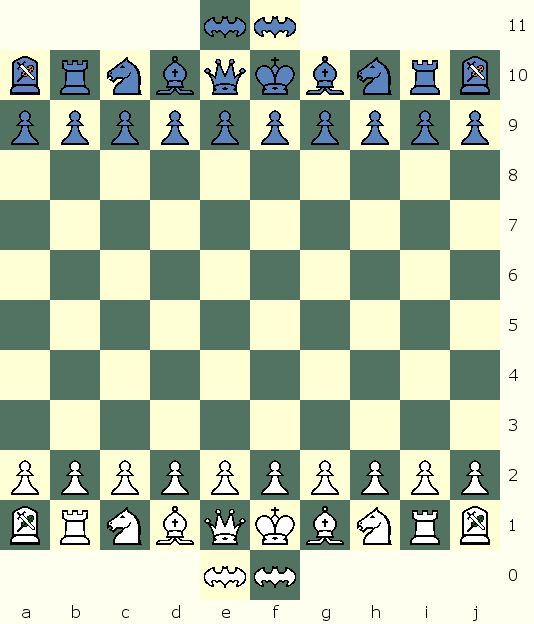 |
Birds and Ninjas Original start position
Coordinates for white. (black mirrors white) Pawns were used instead of Ninja Pawns originally. Eventually drop rule allowing 4 Ninja Pawns was allowed. The drop zone intially proposed were the hangar squares e0,f0 which changed to additionally using the 2nd rank to finally just using the 2nd rank for ninja pawn drops. Currently it is proposed that all pawns be replaced with Ninja Pawns with 5 Ninja Pawns to be dropped. Click here to see starting position #1 |
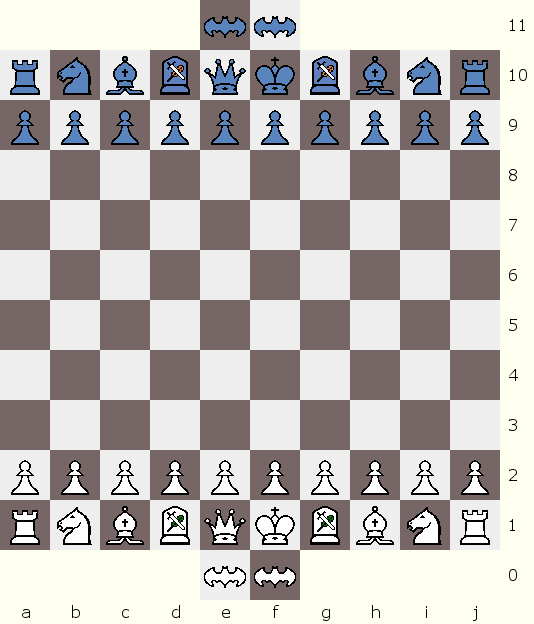 |
Birds and Ninjas Alternate start position
Coordinates for white. (black mirrors white) Rooks on a1,j1 Knights on b1,i1 Bishops on c1, h1 Ninja Guards on d1 and i1 Queen on e1 King on f1 Flying Bombers on e0,f0. Here too, there are a total of 7 Castling positions for each side, the player must make the decision based on whether centralization of rook or king closer to wing is more desirable. Click here to see starting position #1 |
I highly recommend all new users to also check out: Flying Bombers Grand Chess, Wreckage, Asylum Redux, Octopus Chess, Zig Zag Madness or Venomous first.
Click here to play Birds and Ninjas
Click here to play using Alternative Start Position
Click here to play using Alternative Start Position #2
View Game Logs of Birds and Ninjas
Explore Subvariants and other game design ideas within this game here
*see the Ninja Pawn Drop Rule for an enhanced playing experience.
*see the extended landing flying bomber for slightly different moveset.
|
If you would like to email the chess variant inventor directly: inventor@chess.computerwebservices.net
|
|
Posted by: observer on 2008-02-03 20:03:45 Like Chess: YES Hey guy, Notwithstanding your altercation on redhotpawn.com I think you have worked hard on these variants. The bird thing reminds me of a checker piece. Now with respect to you argument over there - think about this would they not be an opening database for this game, and if enough people play, you get the same issue: people looking up openings in the database. So good luck - Try to get the game to be on some where maybe we can try a game .. Posted by: tomtom232 on 2008-02-02 20:31:13 Like Chess: YES this is the worst variant of chess I have ever laid eyes upon...its even worse than suicide chess. Posted by: dutchgambit on 2008-02-02 18:55:52 Like Chess: YES it sucks IMHO Posted by: SwissGambit on 2008-02-02 18:22:32 Like Chess: YES This will go the way of other bigger-board variants like Capablanca Chess. Posted by: kim on 2007-10-12 15:07:27 Like Chess: YES The new pieces are interesting..But like the prev poster said, I need to play it live! Posted by: john on 2007-10-01 18:46:43 I'll play it maybe if available on freechess, but I chess is enough for me. Posted by: inventor@chess.computerwebservices.net on 2007-09-21 21:49:54 Thank you for your interest. This is not a commercial variant, so anyone can technically start up a live server, sell products and make a profit out of it. I do believe many would be interested, but I will not be invested financially in any endeavor. Posted by: John Doe on 2007-09-21 21:45:06 Like Chess: YES
Are you going to market this game, like Omega Chess? I would like to play it live not by correspondence. |

